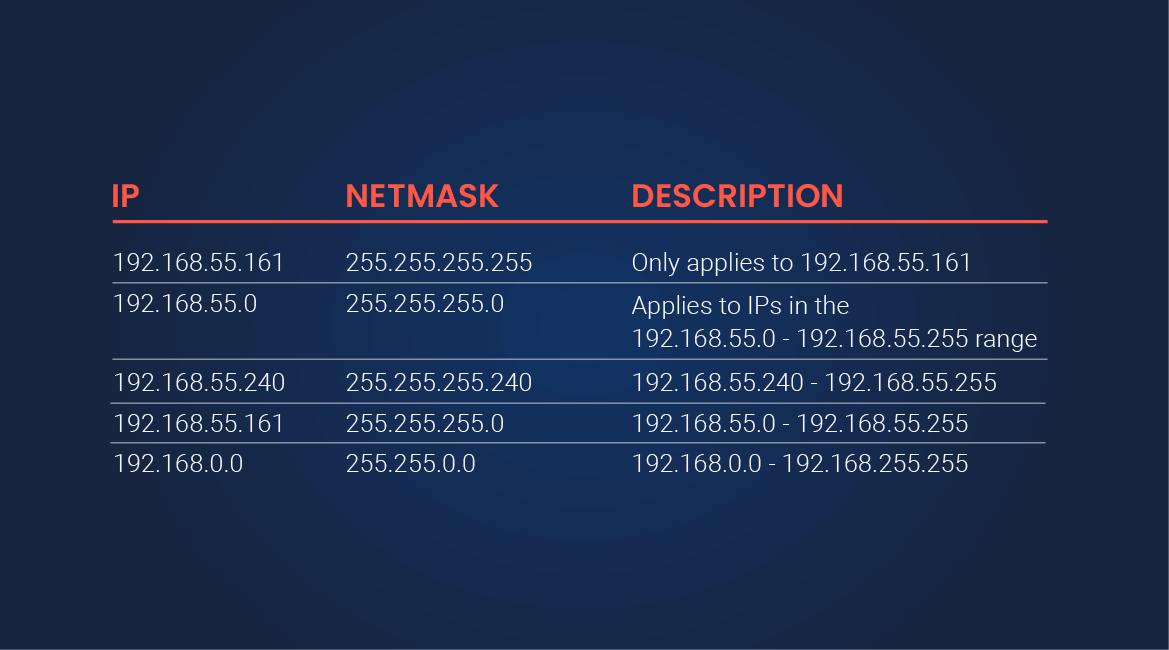Guide to using netmasks in IoT
AN EXPLORATION OF NETWORK SUBNETTING
Learning Objectives
After reading this article you’ll understand:
What a Netmask is
How a Netmask works
Calculating the Netmask and Subnet mask
Netmasking in IoT Network Management
In the realm of IoT and networking, grasping the notion of a netmask and its practical use is crucial for efficient and organized management of your network addresses.
Whether you're an IoT enthusiast or simply curious about what a netmask is, this exploration will equip you with a profound understanding of netmasks, their importance, and their role in effective network management.
Defining a Netmask
At its essence, a netmask is a key element of IP addressing. It serves as a filter, dividing an IP address into two separate sections: the network address and the host address. By specifying the netmask, we can identify which part of the IP address signifies the network and which part denotes the devices within that network.
A netmask is composed of 32 bits, usually depicted in the dotted decimal notation, and is intimately linked to IP addresses. You can see a few examples in the image below.
The term subnet mask is often used to refer to netmasks in the context of segmenting networks into subnets. Both terms are frequently used interchangeably.

The Functioning of a Netmask
To comprehend how a netmask functions, it's vital to understand the binary representation of IP addresses. In binary, an IP address is made up of 32 bits, divided into four octets (sets of eight bits each). The netmask - also represented in binary - consists of a series of consecutive ones (1s) followed by consecutive zeros (0s).
By executing a bitwise AND operation between the IP address and the netmask, we effectively "mask" the host portion, leaving only the network address. This enables devices on the network to ascertain whether a target IP address is within their own network or should be routed to a different network.
Determining the Netmask and Subnet mask
The process of determining netmasks and subnet masks can be intimidating, particularly for those new to networking. However, subnet mask calculators and IP calculators can simplify the process. These online tools allow you to input your IP address and desired number of subnets or hosts, and they automatically generate the suitable netmask or subnet mask.
A netmask can be represented in various notations, such as the dotted decimal notation (e.g., 255.255.255.0) or the CIDR notation (e.g., /24). The CIDR notation offers a succinct representation of the netmask and is widely used in contemporary networking.
The significance of netmasks in network management
Now that we have a grasp of what a netmask is, let’s delve into why you might want to use one. There are 3 primary reasons why employing a netmask is advisable: efficient address utilization, improved security, and streamlined network management.
1. Efficient Address Utilization
Netmasks play a pivotal role in efficiently using IP addresses within a network. By thoughtfully designing subnets and assigning suitable netmasks, you can optimize address allocation, ensuring that each subnet has sufficient addresses to accommodate its devices without squandering valuable IP space.
When determining the netmask for a subnet, it's crucial to find a balance between the number of available host addresses and the number of required subnets. Choosing a netmask that is too restrictive may lead to insufficient host addresses, while an excessively permissive netmask can squander valuable IP addresses.
2. Improved Security
Partitioning a network into subnets using netmasks provides an additional layer of security. By separating devices based on their network addresses, you can implement more detailed access control policies and effectively manage network traffic flow. This helps reduce security risks and potential unauthorized access.
By creating distinct subnets for different departments, guest networks, or critical infrastructure, you can enforce stricter security measures and limit access between subnets. Moreover, deploying Firewall rules and implementing VLANs based on netmasks can further improve network security.
3. Streamlined Network Management
Netmasks streamline network management by facilitating logical grouping of devices based on their IP addresses. With well-defined subnets and netmasks, troubleshooting network issues, implementing changes, and expanding networks become more organized and straightforward. This leads to enhanced operational efficiency and reduced downtime.
Additionally, using netmasks allows you to implement routing protocols and policies more effectively. Routing decisions can be made based on the network portion of the IP address, ensuring that traffic is efficiently directed between subnets.
Conclusion
Netmasks are a fundamental aspect of networking, enabling efficient IP address allocation, improved security, and streamlined network management. Understanding what a netmask is and how it functions empowers IoT enthusiasts and non-engineers alike to make informed decisions when it comes to setting up and managing their networks.
By utilizing netmask calculators and subnet mask calculators, you can easily determine the suitable netmask or subnet mask for your network needs. So, whether you're venturing into the world of IoT or simply want to understand the basics of networking, a solid grasp of netmasks is essential for building robust and well-structured networks.
Remember, netmasks are your partners in optimizing your network's performance, security, and scalability. With their assistance, you can navigate the intricate landscape of network addressing and subnetting, ensuring that your network operates efficiently and securely in the IoT era.

